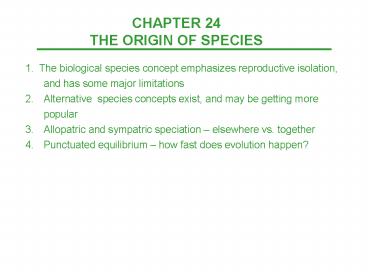Nerve activates contraction PowerPoint PPT Presentation
1 / 19
Title: Nerve activates contraction
1
CHAPTER 24 THE ORIGIN OF SPECIES
- 1. The biological species concept emphasizes
reproductive isolation, and has some major
limitations - Alternative species concepts exist, and may be
getting more popular - Allopatric and sympatric speciation elsewhere
vs. together - Punctuated equilibrium how fast does evolution
happen?
2
Introduction
- Darwin recognized that new species formed in the
Galapagos Islands ( existed nowhere else). - Evolutionary theory must also explain
macroevolution, the origin of new taxonomic
groups (new species, new genera, new families,
new kingdoms) - Speciation is the keystone process in the
origination of diversity of higher taxa.
3
- Two patterns of speciation anagenesis and
cladogenesis. - Evidence fossil record.
- 1. Anagenesis - cumulative changes, gradual
transition or transformation of one species into
another.
Fig. 24.1a
4
- Cladogenesis branching of one or more new
species from a parent species. - Cladogenesis yields more species
Fig. 24.1b
5
- Morphological differences were used for a long
time to distinguish species. - Today, differences in body function,
biochemistry, behavior, and genetic makeup are
also used to differentiate species.
6
1. The biological species concept emphasizes
reproductive isolation
- Ernst Mayr (1942) the biological species concept
- A species is a population or group of populations
whose members have the potential to interbreed
with each other in nature to produce viable,
fertile offspring, but who cannot produce viable,
fertile offspring with members of other species. - A biological species is the largest set of
populations in which genetic exchange is possible
and is genetically isolated from other
populations.
7
- Species interfertility, not physical
similarity. - Example eastern / western meadowlarks - similar
shapes and coloration, but song differences
prevent interbreeding. - Humans considerable diversity,but one species
because ofour capacity to interbreed.
Fig. 24.2
8
- Many species are genetically sequestered by
multiple barriers. - Barriers often intrinsic to the organisms, not
simple geographic separation. - Prezygotic or postzygotic reproductive barriers
- Prezygotic Postzygotic
- habitat isolation hybrid viability
- behavioral isolation reduced hybrid fertility
- temporal isolation hybrid breakdown
- mechanical isolation
- gametic isolation
9
- Reproductive barrierscan occur beforemating,
betweenmating andfertilization, orafter
fertilization.
Fig. 24.5
10
but has some major limitations
- BSC has been important in evolutionary theory,
but its limited when applied to species in
nature. - Reproductive isolation of morphologically-similar
fossils? - Living species do we know about interbreeding
for all? - Asexual species (e.g., bacteria)?
11
2. Alternative species concepts exist, and may
be getting more popular
- Ecological SC based on ecological niche
- Pluralistic SC - invokes reproductive isolation
and/or ecological niche. - Morphological SC old and practical unique set
of structural features. - Genealogical SC - a species a set of organisms
with a unique genetic history - All are attempts to categorize a moving spectrum.
12
3. Allopatric and sympatric speciation
elsewhere vs. together
- How is gene flow among populations initially
interrupted.?
Fig. 24.6
13
- Allopatric the significance of a barrier depends
on the ability of organisms to move about. - The Grand Canyon is a significant barrier 2
closely-related species of ground squirrels on
opposite sides. - Not so for birds.
Fig. 24.7
Fig. 24.9
14
- The odds of allopatric speciation increase when a
population is both small and isolated. - Genetic drift and natural selection are more
likely. - But most small, isolated populations fail.
- A test
Fig. 24.8
15
- Evolution of many species from a common ancestor
is called an adaptive radiation.
Fig. 24.11
16
- Geographic isolation promotes allopatric
speciation, but ? reproductive isolation. - Reproductive isolation must also evolve.
- Natural selection and genetic drift both act as
allopatric populations evolve separately. - Drosophila pseudoobscura cultures (D. Dodd)
- Grew cultures separately on starch or maltose
media - Several generations
- Starch cultures improved on starch, maltose
cultures improved on maltose (natural selection)
17
- Females raised on a starch medium preferred
starch males over males raised in maltose medium. - Prezygotic barrier to interbreeding developed
after only several generations of isolation.
Fig. 24.12
18
- Ditto for postzygotic reproductive barriers
- R. Vickery cross-pollinated allopatric
populations of monkey flower (Mimulus
glabratus). - Planted hybrid seeds - develop into fertile
plants? - Cross plants from different regions proportion
of fertile offspring decreased as distance from
the source populations increased. - Some hybrids almost sterile hybrid breakdown, a
postzygotic barrier.
19
- Allopatric speciation - new species form when
geographically isolated populations evolve
reproductive barriers as a byproduct of genetic
drift and natural selection to its new
environment. - Sympatric speciation new species arise within
the range of the parent populations. - Reproductive barriers must evolve between
sympatric populations. - Polyploidy - common in plants (some animals) -
accidents during cell division result in extra
sets of chromosomes. - Also in animals - gene-based shifts in habitat or
mate preference.

